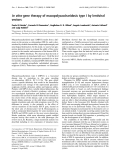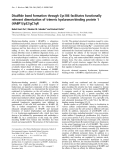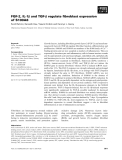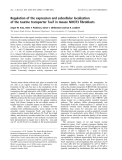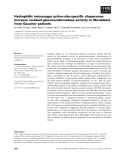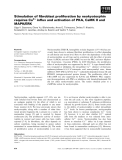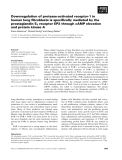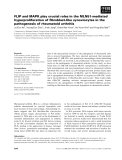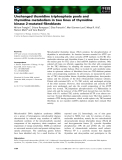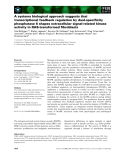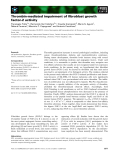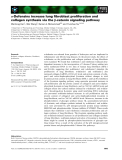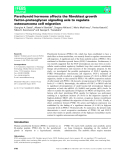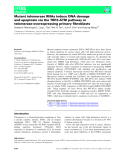
fibroblasts
-
Mucopolysaccharidosis type I (MPS I) results from a deficiency in the enzyme a-L-iduronidase (IDUA), and is characterized by skeletal abnormalities, hepatosplenomegaly and neurological dysfunction. In this study, we used a late generation lentiviral vector to evaluate the utility of this vector system for the transfer and expression of the human IDUA cDNA in MPS I fibroblasts. We observed that the level of enzyme expression in transduced cells was 1.5-fold the level found in normal cells; the expression persisted for at least two months....
 8p
8p  system191
system191
 01-06-2013
01-06-2013
 35
35
 5
5
 Download
Download
-
Duodenase is a 29-kDa serine endopeptidase that displays selective trypsin- and chymotrypsin-like substrate specificity. This enzyme has been localized to epitheliocytes of Brunner’s glands, and as described here, to mast cells within the intestinal mucosa and lungworm-infected lung, implying an important additional role in inflammation and tissue remodelling. In primary cultures of pulmonary artery fibroblasts, duodenase induced a concentration-dependent increase in [3H]thymidine incorporation with a maximal effect observed at 30 nM.
 10p
10p  research12
research12
 01-06-2013
01-06-2013
 56
56
 3
3
 Download
Download
-
Hyaluronan-binding protein 1 (HABP1), a ubiquitous multifunctional protein, interacts with hyaluronan, globular head of complement component 1q (gC1q), and clustered mannose and has been shown to be involved in cell sig-nalling.In vitro, this recombinant protein isolated from human ®broblast exists in dierent oligomeric forms, as is evident from the results of various independent techniques in near-physiological conditions.
 9p
9p  research12
research12
 29-04-2013
29-04-2013
 29
29
 4
4
 Download
Download
-
Basic ®broblast growth factor (bFGF) regulates diversi®ed biological functions in rat Sertoli cells. This report demon-strates that bFGF inhibits steroidogenesis in developing rat Sertoli cells. Follicle stimulating hormone (FSH)-stimulated estradiol production was reduced by bFGF. Moreover, the amount of cytochrome P450 aromatase, responsible for the irreversible transformation of androgens into estrogens, is decreased by bFGF at the transcriptional level.
 10p
10p  research12
research12
 23-04-2013
23-04-2013
 31
31
 2
2
 Download
Download
-
Growth factors, including fibroblast growth factor-2 (FGF-2) and transform-ing growth factor-b(TGF-b) regulate fibroblast function, differentiation and proliferation. S100A8 and S100A9 are members of the S100 family of Ca 2+ -binding proteins and are now accepted as markers of inflammation. They are expressed by keratinocytes and inflammatory cells in human⁄murine wounds and by appropriately activated macrophages, endothelial cells, epithelial cells and keratinocytesin vitro.
 17p
17p  awards
awards
 06-04-2013
06-04-2013
 35
35
 2
2
 Download
Download
-
SHIP2, the ubiquitous SH2 domain containing inositol 5-phosphatase, includes a series of protein interacting domains and has the ability to dephosphorylate phosphatidylinositol 3,4,5-trisphosphate [PtdIns(3,4,5)P3 ] in vitro. The present study, which was undertaken to evaluate the impact of SHIP2 on PtdIns(3,4,5)P3 levels, was performed in a mouse embryonic fibroblast (MEF) model using SHIP2 deficient (–⁄–) MEF cells derived from knockout mice.
 0p
0p  awards
awards
 06-04-2013
06-04-2013
 40
40
 1
1
 Download
Download
-
The cellular level of the organic osmolyte taurine is abalance betweenactiveuptakeandpassive leakviaavolume sensitive pathway. Here, we demonstrate that NIH3T3 mouse fibro-blasts express a saturable, high affinity taurine transporter (TauT,Km¼18lM), and that taurine uptake via TauT is aNa+ -and Cl– -dependent process with an apparent 2.5 : 1 : 1 Na + /Cl – /taurine stoichiometry. Transport activ-ity is reduced following acute administration of H2O2 or activatorsof proteinkinasesAorC.
 13p
13p  awards
awards
 05-04-2013
05-04-2013
 60
60
 4
4
 Download
Download
-
Gaucher disease is an autosomal recessive lysosomal storage disorder caused by the deficient activity of glucocerebrosidase. Accumulation of glucosylceramide, primarily in the lysosomes of cells of the reticuloendo-thelial system, leads to hepatosplenomegaly, anemia and skeletal lesions in type I disease, and neurologic manifestations in types II and III disease.
 11p
11p  inspiron33
inspiron33
 25-03-2013
25-03-2013
 52
52
 4
4
 Download
Download
-
Neokyotorphin [TSKYR, hemoglobina-chain fragment (137–141)] has pre-viously been shown to enhance fibroblast proliferation, its effect depending on cell density and serum level. Here we show the dependence of the effect of neokyotorphin on cell type and its correlation with the effect of protein kinase A (PKA) activator 8-Br-cAMP, but not the PKC activator 4b-phor-bol 12-myristate, 13-acetate (PMA).
 11p
11p  inspiron33
inspiron33
 23-03-2013
23-03-2013
 46
46
 2
2
 Download
Download
-
Many cellular functions of lung fibroblasts are controlled by protease-acti-vated receptors (PARs). In fibrotic diseases, PAR-1 plays a major role in controlling fibroproliferative and inflammatory responses. Therefore, in these diseases, regulation of PAR-1 expression plays an important role.
 11p
11p  galaxyss3
galaxyss3
 07-03-2013
07-03-2013
 36
36
 4
4
 Download
Download
-
One of the characteristic features of the pathogenesis of rheumatoid arth-ritis is synovial hyperplasia. We have reported previously that metastatic lymph node 51 (MLN51) and granulocyte–macrophage colony-stimulating factor (GM-CSF) are involved in the proliferation of fibroblast-like synovi-ocytes in the pathogenesis of rheumatoid arthritis.
 10p
10p  galaxyss3
galaxyss3
 07-03-2013
07-03-2013
 39
39
 3
3
 Download
Download
-
We have previously reported how the release of fibroblast growth factor-2 (FGF-2) is mediated by shed vesicles. In the present study, we address the question of how newly synthesized FGF-2 is targeted to the budding vesicles.
 14p
14p  media19
media19
 06-03-2013
06-03-2013
 27
27
 3
3
 Download
Download
-
Mannose for mammalian glycan biosynthesis can be imported directly from the medium, derived from glucose or salvaged from endogenous or external glycans. All pathways must generate mannose 6-phosphate, the activated form of mannose.
 11p
11p  media19
media19
 05-03-2013
05-03-2013
 30
30
 1
1
 Download
Download
-
Mitochondrial thymidine kinase (TK2) catalyzes the phosphorylation of thymidine in mitochondria. Its function becomes essential for dTTP syn-thesis in noncycling cells, where cytosolic dTTP synthesis via R1⁄R2 ribo-nucleotide reductase and thymidine kinase 1 is turned down.
 10p
10p  vinaphone15
vinaphone15
 27-02-2013
27-02-2013
 39
39
 1
1
 Download
Download
-
Mitogen-activated protein kinase (MAPK) signaling determines crucial cell fate decisions in most cell types, and mediates cellular transformation in many types of cancer. The activity of MAPK is controlled by reversible phosphorylation, and the quantitative characteristics of MAPK activation determine the cellular response.
 12p
12p  vinaphone15
vinaphone15
 27-02-2013
27-02-2013
 40
40
 2
2
 Download
Download
-
Thrombin generation increases in several pathological conditions, including cancer, thromboembolism, diabetes and myeloproliferative syndromes. During tumor development, thrombin levels increase along with several other molecules, including cytokines and angiogenic factors. Under such conditions, it is reasonable to predict that thrombin may recognize new low-affinity substrates that usually are not recognized under low-expression levels conditions.
 13p
13p  viettel02
viettel02
 22-02-2013
22-02-2013
 34
34
 3
3
 Download
Download
-
a-defensins are released from granules of leukocytes and are implicated in inflammatory and fibrotic lung diseases. In the present study, the effects of a-defensins on the proliferation and collagen synthesis of lung fibroblasts were examined. We found thata-defensin-1 and a-defensin-2 induced dose-dependent increases in the incorporation of 5-bromo-2¢-deoxy-uridine into newly synthesized DNA in two lines of human lung fibroblasts (HFL-1 and LL-86)
 12p
12p  viettel02
viettel02
 20-02-2013
20-02-2013
 38
38
 3
3
 Download
Download
-
EVI1 is a nuclear zinc finger protein essential to normal development, which participates in acute myeloid leukaemia progression and transforms Rat1 fibroblasts. In this study we show that enforced expression of Evi1 in Rat1 fibroblasts protects from paclitaxel-induced apoptosis, consistent with previously published studies.
 12p
12p  mobifone23
mobifone23
 18-01-2013
18-01-2013
 33
33
 4
4
 Download
Download
-
Parathyroid hormone (PTH)(1–34), which has been established to have a dual effect on bone metabolism, was recently found to regulate osteosarcoma cell migration. A significant part of the bone anabolic action of PTH(1–34) is attributed to fibroblast growth factor (FGF)-2 stimulation.
 11p
11p  cosis54
cosis54
 09-12-2012
09-12-2012
 59
59
 2
2
 Download
Download
-
Mutant template human telomerase RNAs (MT-hTers) have been shown to induce apoptosis in various cancer cells with high telomerase activity. However, the mechanism by which MT-hTers inhibit the growth of cancer cells and their effects on normal cells remain unknown.
 15p
15p  cosis54
cosis54
 09-12-2012
09-12-2012
 47
47
 3
3
 Download
Download
CHỦ ĐỀ BẠN MUỐN TÌM









